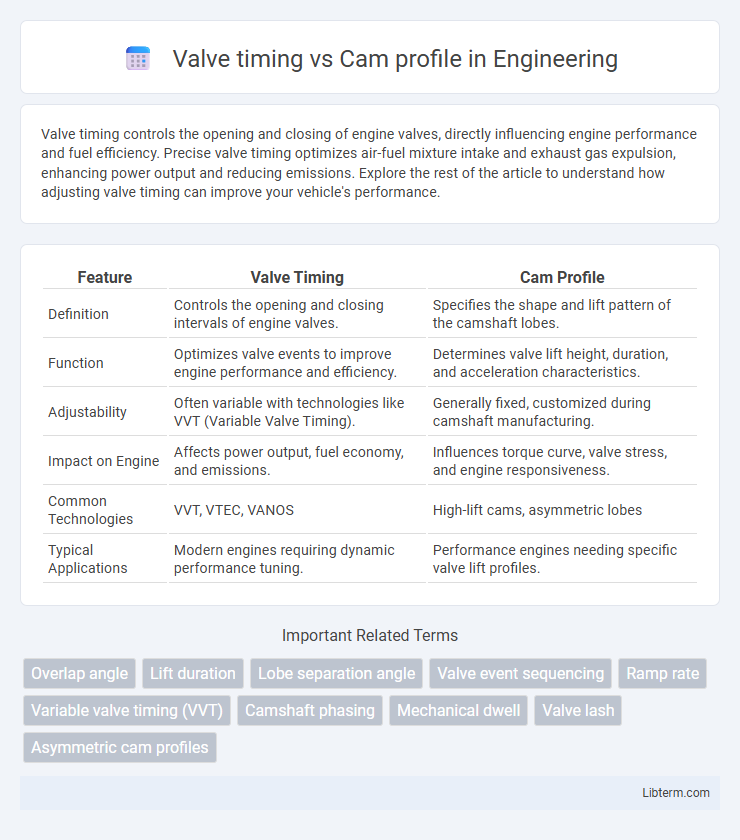Valve timing controls the opening and closing of engine valves, directly influencing engine performance and fuel efficiency. Precise valve timing optimizes air-fuel mixture intake and exhaust gas expulsion, enhancing power output and reducing emissions. Explore the rest of the article to understand how adjusting valve timing can improve your vehicle's performance.
Table of Comparison
| Feature | Valve Timing | Cam Profile |
|---|---|---|
| Definition | Controls the opening and closing intervals of engine valves. | Specifies the shape and lift pattern of the camshaft lobes. |
| Function | Optimizes valve events to improve engine performance and efficiency. | Determines valve lift height, duration, and acceleration characteristics. |
| Adjustability | Often variable with technologies like VVT (Variable Valve Timing). | Generally fixed, customized during camshaft manufacturing. |
| Impact on Engine | Affects power output, fuel economy, and emissions. | Influences torque curve, valve stress, and engine responsiveness. |
| Common Technologies | VVT, VTEC, VANOS | High-lift cams, asymmetric lobes |
| Typical Applications | Modern engines requiring dynamic performance tuning. | Performance engines needing specific valve lift profiles. |
Introduction to Valve Timing and Cam Profiles
Valve timing controls the opening and closing of engine valves, directly impacting engine performance, efficiency, and emissions. Cam profiles determine the shape and lift of the cam lobes, influencing valve movement characteristics such as duration, timing, and lift. Perfect synchronization between valve timing and cam profiles enhances airflow, combustion, and overall engine power output.
Key Concepts: What is Valve Timing?
Valve timing refers to the precise control of when the intake and exhaust valves open and close during an engine's four-stroke cycle, directly influencing engine efficiency and performance. It is determined by the camshaft position relative to the crankshaft, optimizing air-fuel mixture intake and exhaust gas expulsion. Proper valve timing improves combustion, power output, fuel economy, and reduces emissions by ensuring valves operate at the most effective moments.
Key Concepts: What is a Cam Profile?
A cam profile defines the shape and contour of a cam lobe, which controls the timing, duration, and lift of valve movement in an internal combustion engine. Precise cam profiles are essential for optimizing valve timing to enhance engine performance, fuel efficiency, and emissions. Variations in cam profile directly influence valve opening and closing events, impacting airflow and combustion characteristics.
How Valve Timing Impacts Engine Performance
Valve timing directly influences engine performance by controlling the opening and closing of intake and exhaust valves, which affects airflow and combustion efficiency. Optimized valve timing improves power output, fuel efficiency, and emissions by ensuring precise air-fuel mixture intake and exhaust gas expulsion. Variations in valve timing can alter valve overlap and duration, impacting torque curves and overall engine responsiveness.
The Role of Cam Profiles in Power Delivery
Cam profiles directly influence valve timing, dictating the duration and lift of valve openings critical to optimizing engine power delivery. Aggressive cam profiles increase valve lift and duration, enhancing airflow at higher RPMs for improved horsepower, while milder profiles favor low-end torque by ensuring efficient combustion at lower speeds. Precise engineering of cam profiles balances valve overlap and timing to maximize volumetric efficiency, directly impacting torque curves and overall engine performance.
Comparing Valve Timing vs Cam Profile: Core Differences
Valve timing determines the precise moments when the intake and exhaust valves open and close in an engine cycle, directly affecting engine breathing efficiency and performance. Cam profile refers to the shape and design of the cam lobes, which controls valve lift, duration, and acceleration, influencing power output and engine characteristics. While valve timing focuses on the timing of valve events, cam profile concentrates on the physical parameters that drive these valve motions, both essential for optimizing engine functionality.
Adjustable Valve Timing: Technology and Benefits
Adjustable valve timing technology allows precise control over the camshaft's operation, optimizing valve opening and closing events to improve engine efficiency, power output, and emissions. By varying the cam profile dynamically, this system adapts to different engine speeds and loads, enhancing fuel economy and reducing exhaust pollutants significantly. Key implementations like Variable Valve Timing (VVT) and Cam Profile Switching (CPS) highlight the advancements in achieving superior engine performance through real-time adjustment of valve timing.
Cam Profile Design: Factors and Effects
Cam profile design critically influences valve timing by determining the lift, duration, and timing of valve openings. Factors such as cam lobe shape, base circle radius, and ramp curvature directly affect engine performance, fuel efficiency, and emissions. Optimizing cam profile balances valve overlap with engine speed requirements, enhancing torque and power delivery.
Applications in Modern Engines: Real-World Examples
Valve timing and cam profile are critical parameters in modern engine design that directly affect performance, fuel efficiency, and emissions. Variable valve timing (VVT) systems, such as Honda's VTEC and BMW's VANOS, optimize valve timing dynamically to enhance power delivery and fuel economy under various driving conditions, while specific cam profiles are engineered to tailor valve lift and duration for particular engine applications, from high-performance sports cars to fuel-efficient hybrids. Advanced engines combine optimized cam profiles with adjustable valve timing mechanisms to balance horsepower, torque, and emissions compliance in real-world driving scenarios.
Choosing the Right Setup: Performance vs Efficiency
Valve timing controls the precise opening and closing intervals of engine valves, directly influencing engine breathing and combustion efficiency, while cam profile defines the shape and lift of the cam lobes, affecting valve lift and duration. Selecting the right setup involves balancing aggressive cam profiles for enhanced performance at high RPM against conservative valve timing that promotes fuel efficiency and smoother idle. Performance-focused setups favor advanced valve timing and high-lift cam profiles to maximize power output, whereas efficiency-oriented configurations prioritize optimized valve overlap and moderate cam profiles to reduce emissions and fuel consumption.
Valve timing Infographic

 libterm.com
libterm.com